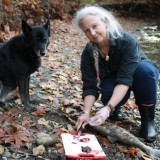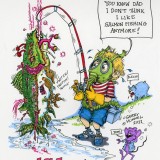The recent news that the European strain of Infectious Salmon Anemia virus had been found in two Rivers Inlet sockeye smolts sent a shiver of fear throughout the North Pacific region. The Canadian Food Inspection Agency (CFIA) dutifully notified Japan, Russia and the United States, the countries with an economic interest in the safety, security and health of wild salmon and other marine fish. The US states of Oregon, California, Idaho and Alaska all expressed alarm, one defining the situation as an “emergency”.
The immediate panic subsided with the CFIA’s recent announcement that re-testing of the sockeye samples did not find ISAv. Were the samples now too old? Had they been improperly stored? Could the original tests, done by one of the world’s reference labs for ISAv, have been faulty? Were the CFIA’s tests faulty? Why had the many tests done on farmed fish not detected ISAv? Why had the Department of Fisheries and Oceans (DFO) not been testing for the disease in wild salmon? Why did no federal agency have a protocol for responding to an ISAv emergency?
As this mystery deepens, the undisputed evidence of ISAv as an international threat was made abundantly clear. BC and its Norwegian salmon farming corporations, together with Canada’s DFO, are playing a high-risk game with extremely serious consequences. Should protective measures fail, an unleashed exotic virus in the North Pacific would be a serious international incident with immeasurable consequences and inestimable costs. Is the gamble worth it?
Meanwhile, more positive tests have been reported for the European strain of ISAv in Pacific wild salmon on the Harrison River, a tributary of the Fraser that is 600 km from Rivers Inlet. A group of worried people led by Alexandra Morton netted a dead, unspawned coho salmon. It’s heart and gill tissue tested positive for ISAv. So did the gill tissue of a “severely jaundiced” Fraser River chinook and a “silver-bright” chum salmon. Finding the virus only in the gills of these fish suggests they were recently infected with ISA (alexandramorton.typepad.com).
Undoubtedly, these tests will be contested. But, as Alexandra Morton writes in her blog (Ibid.), the arrival of ISAv is inevitable.
“I don’t know how no one saw this coming…Every country with salmon farms has taken this path. I am so exhausted with trying to explain this to Ministers, bureaucrats, streamkeepers, environmentalists, fishermen. People just don’t want to believe it…
Look, it is simple. Salmon farms break the natural laws and viruses, bacteria and parasites are the beneficiaries of this behaviour. If you move diseases across the world and brew them among local pathogens, in an environment where predators are not allowed to remove the sick – you get pestilence. There is no other outcome.
The reason I can see this, and where we are headed, is not because I am particularly bright, it is because I have taken great care not to allow myself to become dependent on anyone’s money. I am not climbing any social ladder. I don’t want to be a politician, academic, or CEO of a ‘save the environment’ company. I just want to be able to live between Kingcome and Knight Inlet and not watch it die.”
Her indictment rings too true to be refuted. The salmon farming corporations owe their allegiance to shareholders perpetually hungry for higher profits. In the particular case of ISAv, they are creating a false assurance that will eventually release its viral tragedy. Politicians in power – local, provincial and federal – are busy juggling image, votes and economic considerations. Government bureaucrats and employees are reluctant to rile their political masters. And the majority of the public don’t have the attention or imagination to comprehend and stop this promised catastrophe. The result will be yet another environmental mess.
Are we now witnessing the beginning of this shadowed future? We don’t yet know for certain. As Morton writes so candidly in her blog, she had the premonition of defeat, believing she has “failed in the mission that has consumed my life. I wish now I had put the blinders on and continued studying whales, because it does not matter how the fish die, whether by sea lice, or viruses, they will be dead.”
If the fish die, her failure will be our failure. Because we live on a planet in which all the parts are interconnected, when we threaten or diminish wild salmon, we do the same to ourselves. Their vulnerability is our vulnerability. Or, to put it more ominously, as we dismantle nature’s services, corporate services will rise to fill the void. So the gracious bounty that once was given freely will then be subject to price and profit, a cost that we will pay in currency, dignity and servitude. If ISA is now brewing in our West Coast waters, it will be a classical example of how, piece by piece and place by place, we are dismantling the ecology of our planet. Such a “pestilence” will mark an erosion of our innocence and freedom, a diminishment of ourselves that could have been prevented if only we had possessed a modicum of perspective and caution.
Morton suggests a strategy for prevention and hope. Get the salmon farms out of our marine environment. Now. Immediately. Eliminate the only known source of ISAv and the unnatural concentrations of fish that breed mutations and virulence. This may also mean closing hatcheries for wild fish, too. Should the virus be here, then maybe – just maybe – it will dilute and dissipate in nature’s forgiveness. And if it is not here, the scare was real and instructive, a useful reminder that our folly is as far away as a single virus.




